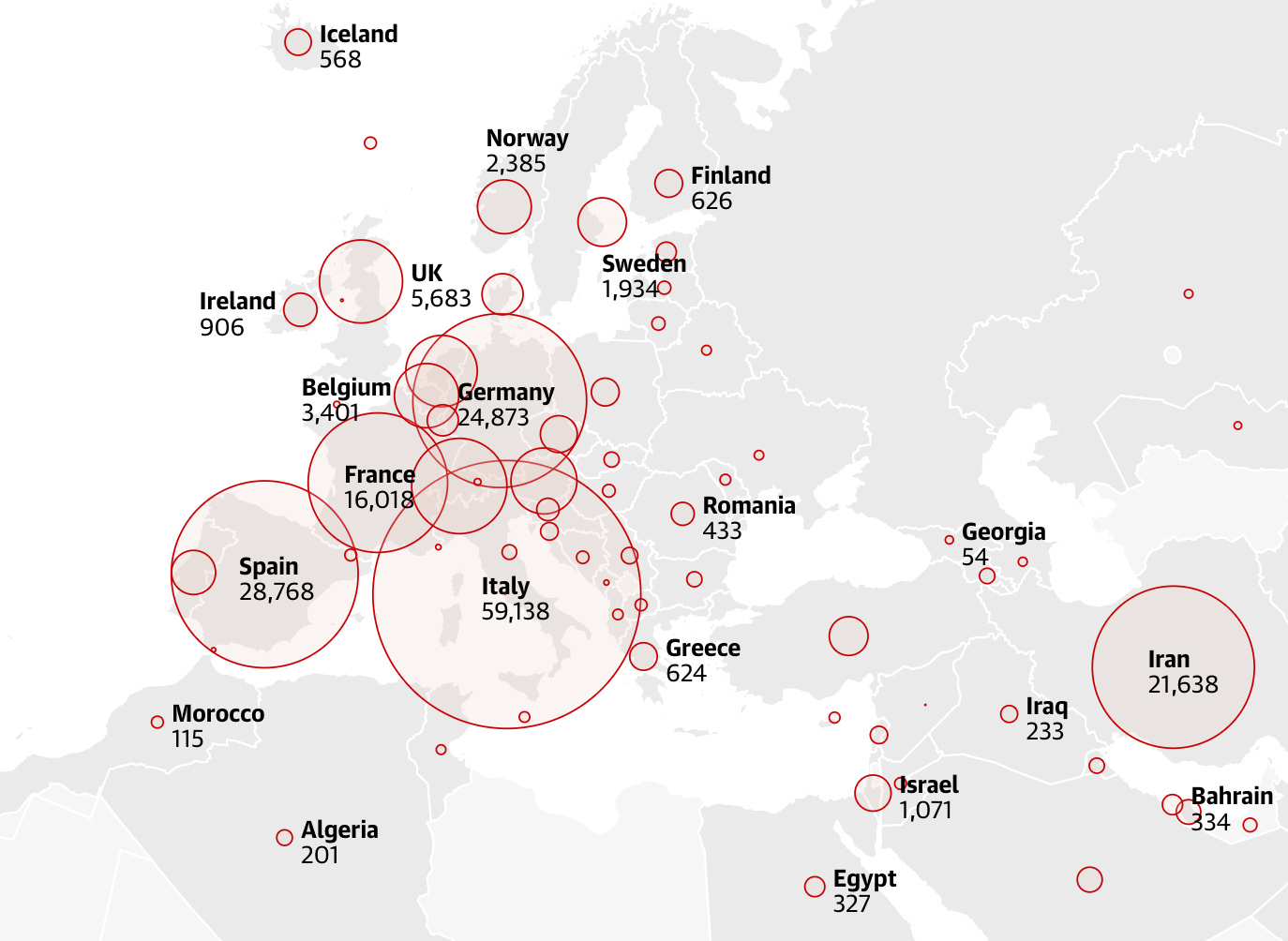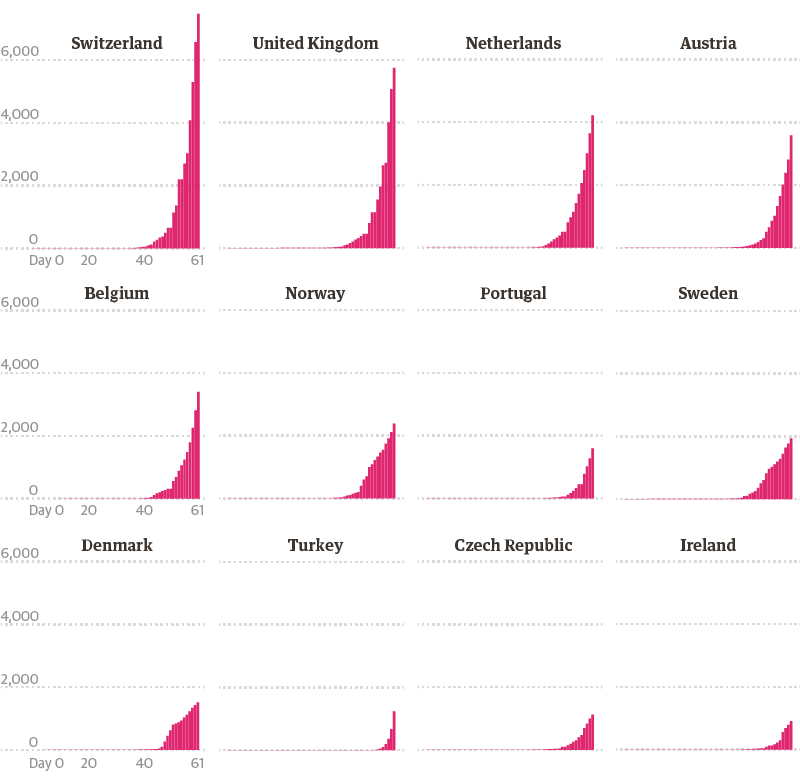Hello! Welcome to another special coronavirus edition of Inside The Newsroom, where we’ll follow on from last week’s newsletter that looked at what every single one of the then 147 countries to have confirmed cases were doing to combat the spread of the virus. Today we’ll look at the ‘curve’ of some of the now more than 170 countries and try to understand what stage each of them is at in terms of slowing what has become one of the worst pandemics on record. Before we get started, I should note that all data includes up to Sunday night and is sourced from Johns Hopkins, who are relying on national governments to release authentic figures. Problem is, there have been reports of the likes of China and Iran covering up the true number of cases and deaths in their countries, which are thought by some to be much higher than the figures we have. And then we have a lack of testing in every country which will certainly miss out on unreported cases. With that in mind, let’s see which countries are on the come down, if any. But first, check out Wednesday’s newsletter where I looked at the numbers of why the U.S. needs Medicare For All. Enjoy. 👇✊
Main Findings
We’ve all heard about China being the center of the outbreak, and more specifically Hubei province (more than that later). The good news coming out of China is that the number of new cases has slowed dramatically and looks to be topping out at a little more than 80,000 cases. But more worrying is the pace at which other countries are now catching up. Italy has been the worst hit of any other country with a shade under 60,000 cases, and has now recorded the most deaths of any country at 5,476, including more than 1,400 over this past weekend alone. Other European countries (more on that later as well) including Spain, Germany and France are following suit. The other big worry is what’s happening in America, where there are now 33,726 cases, which almost doubled just over the weekend and is set to skyrocket in the coming weeks. Look out for a newsletter dedicated to the situation in each U.S. state later this week.
Worst-hit countries with confirmed cases of more than 8,000

There are now more than 170 countries with confirmed cases, including 25 countries with at least 1,000 cases, and another 53 with more than 100 cases. Once all of this is done, you’ll struggle to find a country with cases still in double digits.
Europe Is Now Center of the Outbreak
Europe is now the unofficial center of the outbreak and now has six countries with more than 5,000 confirmed cases. Italy, Spain, France and Germany have been the hardest hit and are now all on full nationwide lockdowns. Foreign Policy’s Keith Johnson reports that in Madrid, he very nearly got fined €30,000 ($32,000/£28,000) for taking out his trash just after midnight. Many other countries including Denmark, Ireland and Sweden are on partial lockdowns, with everything non-essential closed, but stopping short of charging people for stepping outside. The same war-like conditions will likely be imposed across Europe, including here in the UK. Keep calm and carry on, right?
Credit: Pablo Gutiérrez

The worrying thing is that it might be at least two weeks before we know the true impact of the lockdowns on each country’s curve. Italy, for example, has been on lockdown since March 10, but recorded almost 6,000 cases overnight, and another heartbreaking 650 deaths overnight, with no signs of slowing down. Many other European countries including those below are set to also see their number of cases and deaths rise and rise and rise.
Worst-hit European countries with confirmed cases between 1,000 and 8,000

China Reports No New Cases
Some good news at last, as China announced on Thursday of no new locally transmitted cases, and just 130 new cases in the past 24 hours, all for people who have flown back into China from abroad. More good news is that there have been no new cases reported from Hubei — the province where the virus was first identified — for the past five days, a real sign that the spread of the virus has seriously slowed down in mainland China. Quite the tide change from the beginning of the outbreak when just Hubei province alone was reporting around 3,000 new cases a day.
Confirmed cases for each Chinese province

After reports of an initial lack of action and forging of the official figures, the Chinese government appears to have finally controlled the spread of the disease, which looks to have mellowed out at around 80,000 cases across the country. That’s still the most cases of any country, but when you think that China also has the largest population in the world at almost 1.4 billion people, that’s pretty good going. So how did they manage to keep the number of cases relatively low? Well, that’s where it becomes tricky. From everything I’ve consumed over the past couple of months, the only way to stop the spread of a pandemic is to lockdown as soon as possible. Yes, that will mean a gigantic hit to the economy, but the longer you delay the inevitable, the harder the economic impact. And yes, I get that China is an authoritarian dictatorship with a torrid human rights record, but the economic downturn might not be as deep as other countries as a result.
Easier said than done, of course, especially when you read about the draconian conditions the Chinese people had to endure, including people being forced into mass quarantine centers and being kept in their apartments for more than a month. But prohibiting people from leaving their homes isn’t the only way to stop a pandemic, which we’ll get onto next…
Other Far East Countries: How Did/Didn’t They Limit the Spread?
While most of us were trying to beat the January blues, shit was already going down in mainland China. Because of their proximity and being proverbially joined at the hip with China, several other countries were quickly exposed. South Korea’s 8,961 cases make it the worst hit country in the region other than China, and the likes of Malaysia are still seeing alarming daily rises in their number of cases. But for Japan, their handling has been spectacular and unlike any other country. With its enormous 126 million population, including the almost 40 million people in the Tokyo metro area alone, Japan was a recipe for disaster waiting to happen. But around two months after its first confirmed case, how has the country only had 1,007 total cases?
Confirmed cases of Far East countries

Well, like most other countries, there is the possibility that the Japanese government was purposely lax with testing for possible cases, unlike South Korea which tested large portions of its entire population. But unlike South Korea, Japan is due to hold the Olympic Games in just four months, and is astonishingly pushing ahead with it on schedule. Though Canada and Australia became the first countries to announce they would not be sending athletes. So, I say everything with the disclaimer that cases could reasonably be far higher than they are, and also Japan could also experience an explosion of cases any day soon.
Also reasonable is the fact that Japan has dealt with an epidemic originating from China before. In 2003, SARS — Severe Acute Respiratory Syndrome — spread to 29 countries and regions, and killed 774 of the 8,098 people infected. Immediately, the Japanese government ordered examinations of anyone visiting from China and Taiwan, and had quarantine centers in airports ready for anyone suspected of having the virus. They also sent teams of doctors into China to stem the spread.
So when COVID-19 was first detected in early January, Japan was ready. Let’s hope the next time we experience a global pandemic like this in our life time, and we almost certainly will, we are mentally and socially ready to fight.
This week…
Depending on developments of you know what, we’ll try to get back to normal. I’m sitting on a podcast with the amazing Sarah Noeckel, founder of the Femstreet newsletter on women in tech and venture capital.
Thanks for making it all the way to the bottom. Please like and share this edition of Inside The Newsroom by clicking the ❤️ below. That way I’ll appear in clever algorithms and more people will be able to read.
If you haven’t already, please consider subscribing to get a newsletter about a cool news topic in your inbox every time I publish (1-2 times a week). You can find me on Twitter at @DanielLevitt32 and email me corrections/feedback or even a guest you’d like me to get on the podcast at daniellevitt32@gmail.com.



